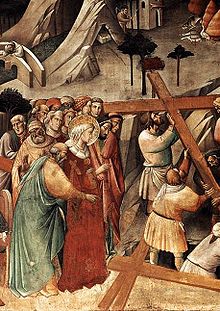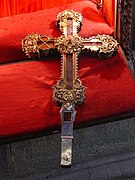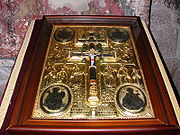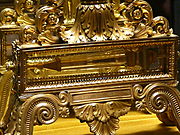True Cross

The True Cross is said to be the real
It is related by numerous historical accounts and
The Roman Catholic Church, Eastern Orthodox Church, Oriental Orthodox Church, and the
Provenance

The Golden Legend
In the Latin-speaking traditions of Western Europe, the story of the pre-Christian origins of the True Cross was well established by the 13th century when, in 1260, it was recorded by
The Golden Legend contains several versions of the origin of the True Cross. In The Life of Adam, Voragine writes that the True Cross came from three trees which grew from three seeds from the "Tree of Mercy" which Seth collected and planted in the mouth of Adam's corpse.[3]
In another account contained in "Of the Invention of the Holy Cross", Voragine writes that the True Cross came from a tree that grew from part of the
After many centuries, the tree was cut down and the wood used to build a bridge over which the Queen of Sheba passed on her journey to meet Solomon. So struck was she by the portent contained in the timber of the bridge that she fell on her knees and revered it. On her visit to Solomon, she told him that a piece of wood from the bridge would bring about the replacement of God's covenant with the Jewish people by a new order. Solomon, fearing the eventual destruction of his people, had the timber buried.[4][5]
After fourteen generations, the wood taken from the bridge was fashioned into the Cross used to crucify Jesus Christ.[4][5] Voragine then goes on to describe its rediscovery by Helena, mother of the Emperor Constantine.[4]
In the
Eastern Christianity
According to the
Tradition of Lot's triple tree
A further tradition holds that these three trees from which the True Cross was constructed grew together in one spot. A traditional Orthodox
Empress Helena and the Cross

Eusebius
The
Socrates Scholasticus

In his Ecclesiastical History, nearly a century after Eusebius,
Sozomen
In his Ecclesiastical History,
Theodoret
Theodoret (died c. 457) in his Ecclesiastical History Chapter xvii gives what would become the standard version of the finding of the True Cross:
When the empress beheld the place where the Saviour suffered, she immediately ordered the idolatrous temple, which had been there erected, to be destroyed, and the very earth on which it stood to be removed. When the tomb, which had been so long concealed, was discovered, three crosses were seen buried near the Lord's sepulchre. All held it as certain that one of these crosses was that of our Lord Jesus Christ, and that the other two were those of the thieves who were crucified with Him. Yet they could not discern to which of the three the Body of the Lord had been brought nigh, and which had received the outpouring of His precious Blood. But the wise and holy Macarius, the president of the city, resolved this question in the following manner. He caused a lady of rank, who had been long suffering from disease, to be touched by each of the crosses, with earnest prayer, and thus discerned the virtue residing in that of the Saviour. For the instant this cross was brought near the lady, it expelled the sore disease, and made her whole.
With the Cross were also found the
Syriac tradition
Another popular ancient version from the
Catholic commemoration
According to the 1955 Roman Catholic Marian Missal, Helena went to Jerusalem to search for the True Cross and found it 14 September 320. In the 8th century, the Feast of the Finding was transferred to 3 May and 14 September became the celebration of the "
The True Cross in Jerusalem
Late antiquity
The silver reliquary that was left at the
Then a chair is placed for the bishop in Golgotha behind the [liturgical] Cross, which is now standing; the bishop duly takes his seat in the chair, and a table covered with a linen cloth is placed before him; the deacons stand round the table, and a silver-gilt casket is brought in which is the holy wood of the Cross. The casket is opened and [the wood] is taken out, and both the wood of the Cross and the
title are placed upon the table. Now, when it has been put upon the table, the bishop, as he sits, holds the extremities of the sacred wood firmly in his hands, while the deacons who stand around guard it. It is guarded thus because the custom is that the people, both faithful and catechumens, come one by one and, bowing down at the table, kiss the sacred wood and pass through. And because, I know not when, some one is said to have bitten off and stolen a portion of the sacred wood, it is thus guarded by the deacons who stand around, lest any one approaching should venture to do so again. And as all the people pass by one by one, all bowing themselves, they touch the Cross and the title, first with their foreheads and then with their eyes; then they kiss the Cross and pass through, but none lays his hand upon it to touch it. When they have kissed the Cross and have passed through, a deacon stands holding the ring of Solomon and the horn from which the kings were anointed; they kiss the horn also and gaze at the ring...[17]
Before long, but perhaps not until after the visit of Egeria, it was possible also to venerate the crown of thorns, the pillar at which Christ was scourged, and the lance that pierced his side.
The Perso-Byzantine Wars
The
Islamic rule and the Crusades

When Jerusalem fell to the Muslims in 638, Heraclius retrieved the True Cross but did not attempt to retake the city.[20]
Around 1009, the year in which
Over the course of each
After
21st-century status
The Greek Orthodox church presents a small True Cross relic shown in the Greek Treasury within the Church of the Holy Sepulchre at the foot of
Dispersion of relics
An inscription of 359 found at Tixter, in the neighbourhood of Sétif in Mauretania (in today Algeria), was said to mention, in an enumeration of relics, a fragment of the True Cross, according to an entry in Roman Miscellanies, X, 441.
Fragments of the Cross were broken up, and the pieces were widely distributed; in 348, in one of his Catecheses, Cyril of Jerusalem remarked that the "whole Earth is full of the relics of the Cross of Christ" and, in another, "The holy wood of the Cross bears witness, seen among us to this day, and from this place now almost filling the whole world, by means of those who in faith take portions from it."
The
Most of the very small relics of the True Cross in Europe came from
The misplacement of which particular class relics of the Holy Cross (and others in general)
By the end of the Middle Ages so many churches claimed to possess relics of the True Cross, that John Calvin is famously said to have remarked that there was enough wood in them to fill a ship:
There is no abbey so poor as not to have a specimen. In some places there are large fragments, as at the Holy Chapel in Paris, at Poitiers, and at Rome, where a good-sized crucifix is said to have been made of it. In brief, if all the pieces that could be found were collected together, they would make a big ship-load. Yet the Gospel testifies that a single man was able to carry it.
— Calvin, Traité Des Reliques
Conflicting with this is the finding of
Smyrnakis notes that the largest surviving portion, of 870,760 cubic millimetres, is preserved in the Monastery of
Santo Toribio de Liébana in Spain is also said to hold the largest of these pieces and is one of the most visited Roman Catholic pilgrimage sites. In Asia, the only place where the other part of the True Cross is located is in the Monasterio de Tarlac at San Jose, Tarlac, Philippines.[40]
The
In 2016, a relic of True Cross held by
In February 2020, the
-
An enamelled silver reliquary of the True Cross from Constantinople, c. 800
-
One of the largest purported fragments of the True Cross is at Santo Toribio de Liébana in Spain (photo by F. J. Díez Martín)
-
A "Kreuzpartikel" or fragment of True Cross in theSchatzkammer (Vienna)
-
Fragments of True Cross in the Serbian Orthodox Monastery of Visoki Dečani
Veneration

John Chrysostom wrote homilies on the three crosses:
Kings removing their diadems take up the cross, the symbol of their Saviour's death; on the purple, the cross; in their prayers, the cross; on their armour, the cross; on the holy table, the cross; throughout the universe, the cross. The cross shines brighter than the sun.
The
In addition to celebrations on fixed days, there are certain days of the
Image gallery
-
Reliquary of the True Cross atNotre Damein Paris
-
Base of the reliquary with one of the Holy Nails
-
A second reliquary with another nail at Notre Dame
-
A reliquary of the True Cross from the former Premonstratensian monastery in Rüti, Switzerland
See also
- Gospel of Nicodemus, apocryphal text
- Holy Grail, motif from the Arthurian literature
- Holyrood (cross)
- Île de la Cité
- Santa Croce in Gerusalemme
- Stavelot Triptych
- Tree of Jesse
- Relics associated with Jesus
- Arma Christi
- Holy Chalice, chalice used at the Last Supper
- Holy Lance and Holy Sponge
- Shroud of Turin
- Titulus Crucis
- Holy Prepuce
Notes
- hagiographieswhich produced its more usual modern sense.
- Latin: Capta igitur urbe, divitiae repperiuntur inestimabiles, lapides preciosissime et incomparabiles, pars etiam ligni dominici, quod per Helenam de Iherosolimis translatum, auro et gemmis precioses insignitum in maxima illic veneratione habebatur, ab episcopis qui presentes aderant incisum, ab aliis preciosissimis reliquis per nobilis quosque partitur, et postea eis revertentibus ad natale solum, per ecclesias et cenobia distrbuitur.
German: Nach der Eroberung der Stadt wurden unschätzbare Reichtümer gefunden, unvergleichlich kostbare Edelsteine und auch ein Teil des Kreuzes des Herrn, das, von Helena aus Jerusalem überführt und mit Gold und kostbaren Edelsteinen geschmückt, dort höchste Verehrung erfuhr. Es wurde von den anwesenden Bischöfen zerstückelt und mit anderen sehr kostbaren Reliquien unter die Ritter aufgeteilt; später, nach deren Rückkehr in die Heimat, wurde es Kirchen und Klöstern gestiftet.[35] - ^ See also the discussion of the relics of the True Cross on the German Wikipedia at de:Diskussion:Kreuzerhöhung.
- etymon "inventiō"—of anything which has been found or come across, rather than something created entirely new.
References
- ^ Holt (1904).
- ^ a b Drijvers (1992).
- ^ Ellis & al., Vol. I (1900).
- ^ a b c d Ellis & al., Vol. III (1900).
- ^ a b c d Herzog (1969), p. 68.
- ^ a b Roman, Alexander. "Feast of the Exaltation of the Cross". Ukrainian Orthodoxy. Archived from the original on 2016-03-03. Retrieved 2012-10-27.
- ^ Kittel & al. (1969), p. 627.
- ^ "Enormous 'foot-shaped' enclosure discovered in Jordan Valley". Science 2.0. 6 April 2009. Archived from the original on 19 November 2018. Retrieved 19 November 2018.
- ^ a b Richardson (1890).
- ^ Zenos (1890), Ch. xvii.
- ^ Hartranft (1890).
- ^ a b c d Saint-Laurent (2015), p. 42.
- ^ Wiles & al. (2001), p. 57.
- ^ Meerson & al. (2014), p. 121.
- ^ Pogossian (2019), p. 167.
- ^ "Exaltation of the Holy Cross". Franciscan Media. 14 September 2020. Retrieved August 11, 2022.
- ^ McClure & al. (1919).
- ^ Treadgold (1997), p. 299.
- ^ Zuckerman (2013), pp. 197–218.
- ^ Norwich (1988), p. 308.
- ^ Runciman (1951), p. 294.
- ^ a b Hamilton & Jotischky (2020), p. 37.
- ^ a b Hamilton & Jotischky (2020), p. 38.
- ^ Malouf (1983).
- ^ Ciggaar & Teule (1996), p. 38.
- ^ Madden (2005), p. 76.
- ^ "Church of the Holy Sepulchre Chapels". See the Holy Land. 2010-03-15. Archived from the original on 2016-01-10. Retrieved 2016-01-08.
- ^ "Relic of the True Cross to be on View at St. Vartan Cathedral". The Armenian Church: Eastern Diocese of America. 6 September 2018. Archived from the original on 29 August 2021. Retrieved 2 May 2020.
- ^ መጽሐፈ ጤፉት [Mäṣḥafä Ṭefut, Book of Ṭeff Grains] (PDF) (in Geez) – via dirzon.com.
• መጽሐፈ ጤፉት. Retrieved 2023-10-10 – via scribd.com. - ^ Gifford (1894).
- ^ Duval (1982), pp. 331-337 & 351–353.
- ^ Ziehr (1997), p. 62.
- ^ White & al. (1915).
- ^ Studies in the Early History of Shaftesbury Abbey. Dorset County Council, 1999
- ^ Waitz (1880), p. 203.
- ^ Stone (1939), Ch. 82: Of the Marvels of Constantinople.
- ^ Marucchi & al. (1908).
- ^ Ziehr (1997), p. 63.
- ^ Smyrnakis (1903), pp. 378–379.
- ^ "Monasterio de Tarlac". Archived from the original on 2019-03-06. Retrieved 2019-03-04.
- ^ E. A. Wallis Budge, A History of Ethiopia: Nubia and Abyssinia, 1928 (Oosterhout, the Netherlands: Anthropological Publications, 1970), pp. 454f.
- ^ O'Shea, James (2016-07-25). "Truth Revealed about Irish Relic of Cross on which Jesus was Crucified". Irish Central. Retrieved 2019-07-04.
- ^ Novoderezhkin (2020).
- ^ Roth (2022).
- ^ "Compendium of the Reforms of the Roman Breviary, 1568–1961: Part 10.1—The Reform of 1960". New Liturgical Movement. Retrieved 2021-05-02.
- ^ "14 September (27 September): The Elevation of the Venerable and Life-Creating Cross of the Lord". Orthodox Church in America. Archived from the original on 2002-02-25. Retrieved 2022-05-24..
- ^ "Procession of the Honorable Wood of the Life-Giving Cross of the Lord". Orthodox Church in America. Archived from the original on 2012-02-05. Retrieved 2012-03-21.
Bibliography
- Ciggaar, Krijnie; Teule, Herman (1996). East and West in the Crusader States. Peeters. ISBN 90-429-1287-1..
- Cynewulf (1904). The Elene of Cynewulf. Yale Studies in English. Vol. 21. Translated by Holt, Lucius Hudson..
- Cyril of Jerusalem; et al. (1894). Catechetical Lectures [and] Select Orations. A Select Library of the Christian Church: Nicene and Post-Nicene Fathers, 2nd ser., vol. VII. Translated by Gifford, Edward Hamilton; et al. New York: Christian Literature Publishing..
- Drijvers, Jan Willem (1992). "Helena Augusta, the Mother of Constantine the Great and the Legend of Her Finding of the True Cross".
- Duval, Yvette (1982). Loca Sanctorum Africae: Le Culte des Martyrs en Afrique du IVe au VIIe Siècle (in French). Rome: Ecole française de Rome.
- Egeria (1919). The Pilgrimage of Etheria. Translated by McClure, M.L.; C.L. Feltoe. London: Society for Promoting Christian Knowledge..
- . A Select Library of the Christian Church: Nicene and Post-Nicene Fathers, 2nd ser., vol. I. Translated by Richardson, Ernest Cushing; et al. New York: Christian Literature Publishing..
- Hamilton, Bernard; Jotischky, Andrew (2020). Latin and Greek Monasticism in the Crusader States. Cambridge: Cambridge University Press. ISBN 978-0-521-83638-8..
- Herzog, Sadja (1969). "Gossart, Italy, and the National Gallery's Saint Jerome Penitent". Report and Studies in the History of Art. Vol. 3. National Gallery of Art. pp. 67–70. JSTOR 42618036..
- Jacobus de Voragine (1900). "The Life of Adam". The Golden Legend... Vol. 1. Translated by Ellis, Frederick Startridge; et al. London: J.M. Dent & Co.
- Jacobus de Voragine (1900). "Of the Invention of the Holy Cross & First of This Word Invention". The Golden Legend... Vol. 3. Translated by Ellis, Frederick Startridge; et al. London: J.M. Dent & Co.
- Kittel, Gerhard; et al., eds. (1969). Theological Dictionary of the New Testament. Vol. 6. Wm. B. Eerdmans. ISBN 9780802822482..
- Madden, Thomas F. (2005). The New Concise History of the Crusades. Rowman & Littlefield. ISBN 0-7425-3822-2..
- Malouf, Amin (1983). The Crusades through Arab Eyes..
- Marucchi, Orazio; Cabrol, Fernand; Thurston, Herbert (1908). . Catholic Encyclopedia. Vol. 4.
- Meerson, Michael; et al. (2014). Toledot Yeshu: The Life Story of Jesus. Vol. 1. Tübingen: Mohr Siebeck. ISBN 9783161534812..
- Norwich, John Julius (1988). Byzantium: The Early Centuries. London: Guild Publishing..
- Novoderezhkin, Anton (26 February 2020). "Christian Relic, a True Cross Piece, to Be Kept at Russia's Black Sea Fleet Flagship". TASS. Sevastopol. Retrieved 24 May 2022.
- Pogossian, Zaroui (2019). "Relics, Rulers, Patronage: The True Cross of Varag and the Church of the Holy Cross of Ałt'amar". The Church of the Holy Cross of Ałt'amar: Politics, Art, Spirituality in the Kingdom of Vaspurakan. Armenian Texts and Studies, vol. 3. Leiden: Brill. pp. 126–206. ISBN 978-90-04-40038-2..
- Robert of Clari (1939). Three Old French Chronicles of the Crusades. Translated by Stone, Edward N. Seattle: University of Washington..
- Roth, Andrew (15 April 2022). "Loss of Moskva Strikes Serious Blow to Russian Military's Prestige". The Guardian. Archived from the original on 15 April 2022. Retrieved 15 April 2022.
- ISBN 0-521-34770-X..
- Saint-Laurent, Jeanne-Nicole Mellon (2015). Missionary Stories and the Formation of the Syriac Churches. Oakland: University of California Press. ISBN 978-0-520-28496-8.
- Smyrnakis, Gerasimos (1903). Το Άγιο Όρος. Αρχαιολογίας κ.λπ., του Αγίου Όρους [The Holy Mountain. Archaeology, etc., of Mt. Athos] (in Greek). Athens: Anestes Konstandinides.
- Sozomenus (1890). Church History. A Select Library of the Christian Church: Nicene and Post-Nicene Fathers, 2nd ser., vol. II. Translated by Hartranft, Chester D.; et al. New York: Christian Literature Publishing.
- Socrates (1890). Church History. A Select Library of the Christian Church: Nicene and Post-Nicene Fathers, 2nd ser., vol. II. Translated by Zenos, A.C; et al. New York: Christian Literature Publishing..
- Treadgold, Warren (1997). A History of the Byzantine State and Society. Stanford: Stanford University Press. ISBN 0-8047-2630-2.
- Waitz, Georg, ed. (1880). Scriptores Rerum Germanicarum in Usum Scholarum. Monumenta Germaniae Historica (in Latin). Vol. 18. Hannover: Impensis Bibliopolii Hahniani.[dead link]
- "The Anglo-Saxon Chronicle on Alfred the Great". Source Problems in English History. Translated by White, Albert Beebe; et al. New York: Harper & Bros. 1915.
- Wiles, Maurice F.; et al. (2001). Studia Patristica: Papers Presented at the Thirteenth International Conference on Patristic Studies Held in Oxford, 1999. Leuven: Peeters. ISBN 978-90-429-0881-9.
- Ziehr, William (1997). Das Kreuz (in German). Stuttgart: Belser.
- Zuckerman, Constantin (2013). "Heraclius and the Return of the Holy Cross". Constructing the Seventh Century. Travaux et Mémoires. Vol. 17. Paris: Association des Amis du Centre d'Histoire et Civilisation de Byzance. ISBN 978-2-916716-45-9.
Further reading
- Deuffic, Jean-Luc, ed. (2005), Reliques et Sainteté dans l'Espace Médiéval (in French), Pecia, archived from the original on 2008-01-17.
- Frolow, A. (1961), La Relique de la Vraie Croix: Recherches sur le Développement d'un Culte (in French), Paris: Institut français d'études byzantines.
- Murray, Alan V. (1998), "Mighty against the Enemies of Christ: The Relic of the True Cross in the Armies of the Kingdom of Jerusalem", The Crusades and Their Sources: Essays Presented to B. Hamilton, Aldershot, pp. 217–238.
- Olmi, Massimo (2015), Indagine sulla Croce di Cristo (in Italian), Torino: La Fontana di Siloe.
- Olmi, Massimo (2018), I Segreti delle Reliquie Bibliche (in Italian), Rome: XPublishing.
External links
- Fernand Cabrol, "The true Cross": a Catholic view
- Relic of the True Cross in Wrocław, Poland Archived 2016-05-21 at the Wayback Machine








